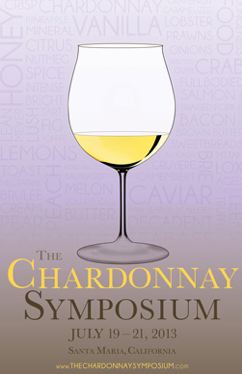Finding the Central Coast
The Central Coast AVA, established in 1985, is vast, stretching 250 miles along the California coastline from
the San Francisco Bay to Santa Barbara County. It is the largest AVA in California, encompassing six counties,
and averaging 25 miles in width, stretching over 4 million (or 5 million depending on the source) acres with
90,300 to 100,000 acres (again, depending on the source) planted to wine grapes. 50% of the plantings are
Chardonnay. There are approximately 600 wineries, producing 15% of the state’s wine production. 30 smaller
sub-AVAs reside within the large Central Coast AVA.
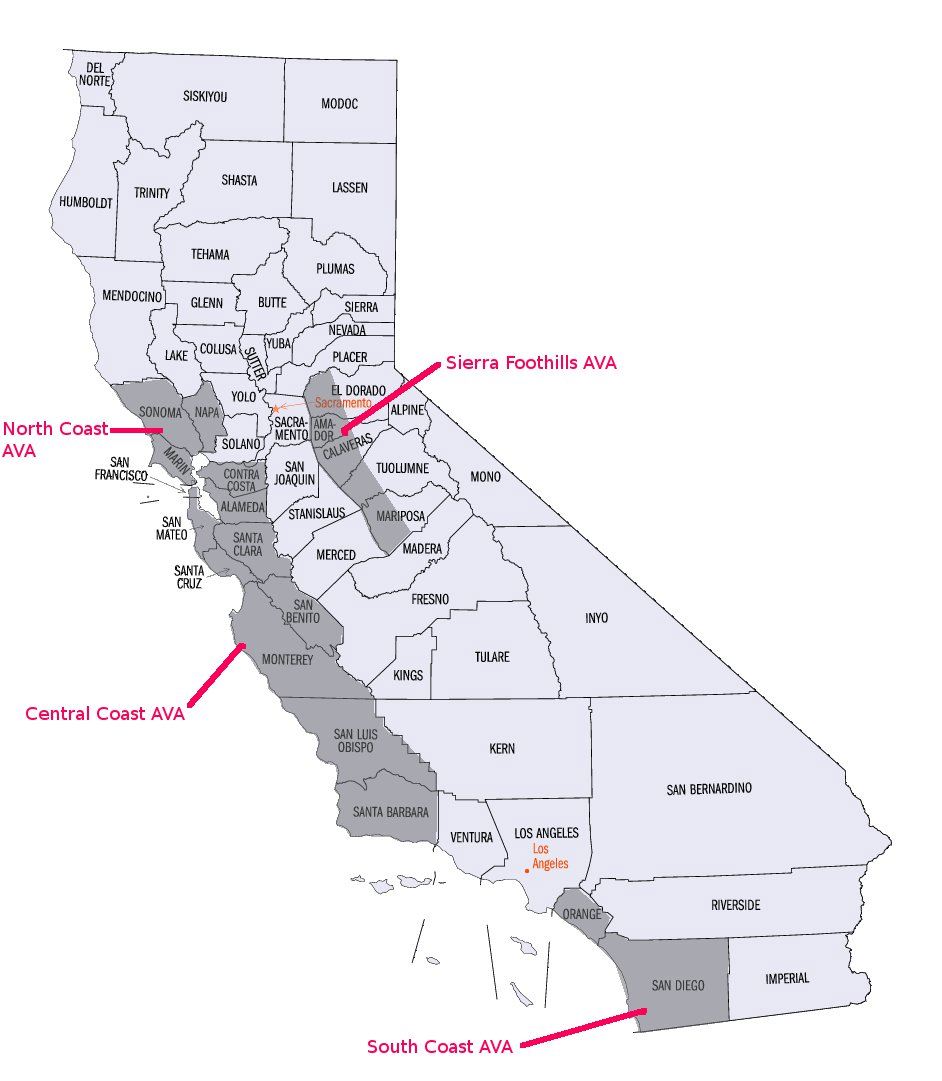
Not surprisingly, consumers are confused about the Central Coast. Andrew Adams, writing in Wines & Vines (March 19, 2013), noted that Michael Heintz, the senior marketing director for E. & J. Gallo reported, “Surveys
of consumers found the term “Central Coast” often left them confused or thinking of the central coast areas
nearest to where they lived.” Some consumers thought Paso Robles and San Luis Obispo were in Mexico!
It might be prudent for World of Pinot Noir to change its name to Central Coast Pinot Noir Festival and limit the
wines to those produced in the Central Coast AVA or wines made from grapes grown in the Central Coast AVA.
The Grand Tasting venue could be divided into, for example, Santa Lucia Highlands & Monterey County, San
Luis Obispo including Arroyo Grande and Edna Valley, Santa Maria Valley and Santa Rita Hills. The Pinot
Noirs from each of these regions do have some regional characteristics and this could be emphasized to the
attendees. I believe regional identity is a key factor in consumer wine buying decisions.
One of the challenges of the Central Coast is that it is largely agricultural and lacks the infrastructure for
tourism found in popular California wine tourism appellations such as Sonoma County and Napa County.
Santa Cruz Mountains does have many lodging and restaurant choices, but the wineries are spread out, many
wineries are open infrequently or not at all, and the region does not condone proper signage that would make it
more convenient to find winery locations. San Luis Obispo has some limited tourism infrastructure and is
reasonably close to Edna Valley and Arroyo Grande. Santa Maria Valley is lacking but is only a thirty minute drive from good lodging and restaurant choices in the Santa Ynez Valley. Santa Rita Hills is reasonably close
to Santa Ynez and Buellton.
After the World of Pinot Noir, I spent a morning with James Ontiveros, owner of Rancho Ontiveros Vineyard in
the Santa Maria Valley and Native 9 Wines, partner in Alta Maria Winery with winemaker Paul Wilkins, and
Director of Sales and Marketing at Bien Nacido Vineyard, Solomon Hills Vineyard, French Camp Vineyard and
Central Coast Wine Services. He is a 9th-generation land owner whose ancestors owned the 8,900-acre
Rancho Tepusquet land grant in northern Santa Barbara County. A graduate of Cal Poly San Luis Obispo,
James has spent much of his life in the Central Coast.
I jumped in his car, and with his family dog on my lap, we set off to view the vineyards and wineries of the
Santa Maria Valley. I learned a bit of history of the region as well. We traversed both the Eastern and Western
portions of the east-west transverse valley and river lands, a huge alluvial plain cut out by the Santa Maria
River. This transverse valley is responsible for the suitability of the Santa Maria Valley AVA for wine grape
growing. Cool maritime influences are channeled into the wide valley, and if the Santa Maria Valley was not
situated at this southerly latitude, it would be too cool to ripen grape varieties to full maturity. The combination
of maritime winds and fog produces a long growing season averaging 125 days from bloom to harvest. The
daytime temperature rarely exceeds 75º F and it is rare for the AVA to receive enough excessive heat to shut
down the vines. The map below can be seen full size at www.santamariavalleywinecountry.com. Looking at
the map, one can appreciate that there is still a vast amount of undeveloped prime vineyard land that is
currently being used for cattle grazing and other agricultural pursuits.
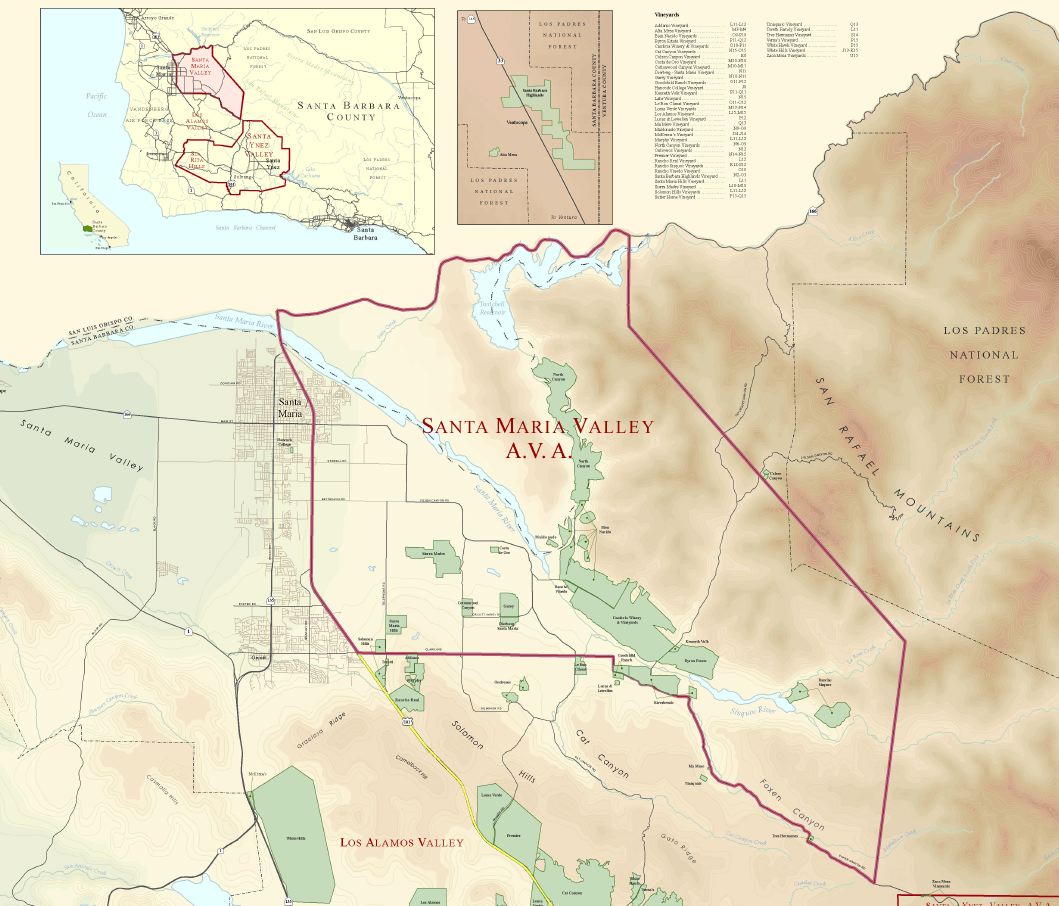
The most striking new development in the Santa Maria Valley is the widespread replacement of old vines
originally planted in the early 1970s. The replacement of old vines varies from hundreds of acres at Cambria
and Byron to more modest re-plantings at vineyards like Bien Nacido and Clark and Telephone. The Nielson
Vineyard at Byron is the oldest commercial vineyard in Santa Barbara County and was planted in 1964, but is
now being replaced with the newest rootstocks and clones, taking advantage of modern viticulture knowledge
and years of winegrowing experience in the Santa Maria Valley. James pointed out how the newer plantings in
the valley are being laid out with more consideration of aspect and topography. Some would decry the loss of
old vines, but James responds that the much of the old vine acreage had been under performing and
underwhelming. “Small blocks of old vines are interesting, but we don’t need thousands of acres.”
While attending Cal Poly San Luis Obispo, James met Paul Wilkins. They started the campus Vines & Wines
Club modestly with only twelve members. After graduating from college, James went to work for E. & J. Gallo
in Sonoma County, unaware that the Vines & Wines Club had become the most popular club on campus. He
received a call from one of the club’s members asking permission for a group to visit Gallo. James didn’t think
to ask exactly how many people would attend. On the day of the visit, two busloads of college kids showed up.
70% of the club had become girls and James was suddenly confronted with a “Girls Gone Wild” scenario.
Paul became a winemaker after college, and in 2005, he and James became partners in Alta Maria Winery &
Vineyards. Alta Maria Pinot Noir is intended to be a reasonably priced “snapshot of the Santa Maria Valley.”
James has gradually locked up long-term sources for grapes for Alta Maria including Bien Nacido, Rancho
Sisquoc, and Garey Vineyard.
James is most excited about the newest Alta Maria vineyard source. He has obtained a long term lease with
an option to buy the 27-acre vineyard, Rancho Vinedo, located adjacent Bien Nacido Vineyard and possessing
very similar soils (the vineyard site is visible on the map above). The vineyard was originally planted in 1972
and has been a source of grapes for Au Bon Climat. A family-run project, the vineyard has been slightly
neglected and subjected to years of herbicides. James is upgrading the farming to organic, altering the
pruning and trellising regimen, interplanting, and converting some of the Chardonnay back to Pinot Noir. Many
years ago, Jim Clendenen and Adam Tolmach advised the vineyard owners to graft a portion of the Pinot Noir
over to Chardonnay. Some of those vines are now being refocused by James to return them to Pinot Noir
production, giving him 42-year-old own-rooted Pinot Noir vines. Remarkably, the vineyard was part of the
Ontiveros family’s original ranch, so in essence, he is “slowly taking it back.” A new name for the vineyard is
under consideration.
We drove to Rancho Sisquoc, the site of previous Santa Barbara County Harvest Festivals. At the eastern
edge of the Santa Maria Valley, the property spans an astounding 36,000 acres of which 300 acres are planted
to vineyards. This area is less windy and warmer in some parts allowing varieties such as Cabernet
Sauvignon, Merlot, Syrah and Sauvignon Blanc to be successfully grown there. The Flood family, who were
notable silver kings in Nevada, have owned the property since the early 1970s. James worked as a cowboy on
the ranch while a student at Cal Poly San Luis Obispo. The Ranch Sisquoc winery tasting room is a real
throwback to the early ranching days of the Santa Maria Valley and with the cattle headquarters adjacent, one
sees cowboys and winemakers intermingling.
Our final stop was Presqu’ile Winery, located on Clark Road, on the western side of the Santa Maria Valley
close to Solomon Hills and Clark & Telephone vineyards. This is a remarkable property, when completed in
June 2013, will become the jewel of the Santa Maria Valley AVA. Presqu’ile (“press-KEEL”) is owned by the
Murphy Family who named the winery Presqu’ile, after the Creole word meaning “almost an island.” The
reference is to the gathering place of the Murphy family on the Gulf Coast until Hurricane Katrina ended an era.
Four generations of the Murphy family have partnered in farming, forestry, oil and gas, and conservation.
Today, two generations of Murphys have joined with winemaker Dieter Cronjie and vineyard manager Jim
Stollberg to form the soul of Presqu’ile.
The 73 acres of certified sustainably farmed vineyards are located on a 200-acre property. The Murphys have
added to the initial plantings of the previous Addamo vineyards on the site. Pinot Noir, Chardonnay, Sauvignon
Blanc and a little Nebbiolo make up the vineyard composition. Beginning with the 2010 vintage, most of the
Presqu’ile wines became estate grown.
James took me on a tour of the new visitor center, caves and winery built into a hillside. Although still under
construction, the facility is already stunning with a tasteful modern architectural presence, and a large gravityflow
winery outfitted with all the latest winemaking technology. Visitors will be taken from the caves by elevator
to an entertainment venue that offers a breathtaking view of the entire Santa Maria Valley. This will
undoubtedly become the first stop for visitors to the Santa Maria Valley and significantly increase the
awareness among consumers of the magnificence of the wines from the Santa Maria Valley.
The Murphys have become partners in Alta Maria Winery & Vineyards and the Alta Maria vines will be
produced at the new Presqu’ile winemaking facility. Matt Murphy (cap), Jonathan Murphy (jacket) and Dieter
Cronjie (gray sweater) are pictured. Visit www.presquilewine.com and www.altammaria.com.
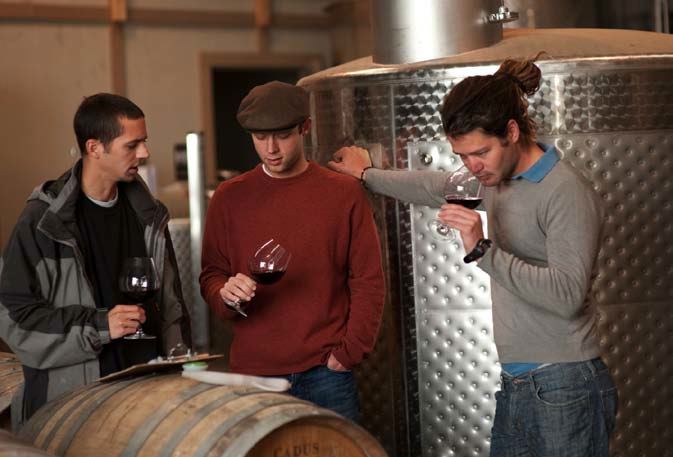

2010 Alta Maria Vineyards Santa Maria Valley Pinot Noir
14.3% alc., pH 3.69, TA 0.53, 4200
cases, $28. Aged 17 months in 33% new French oak barrels. Sixth vintage.
·
Moderate reddish-purple
color in the glass. Nicely perfumed with aromas of cherries, berries, red plum and spice. Mid weight
pleasing flavors echo the nose. The “Santa Maria” spice component is vivid and quite evident on the
finish. A well-crafted wine perfect for the dinner table. Good (+).

2011 Byron Santa Maria Valley Pinot Noir
13.5% alc., pH 3.74, TA 0.50, 15, 207 cases, $29.
100% estate-owned Nielson Vineyard fruit. This wine comes from both older Pinot Noir vines
planted on their own rootstock and new vines planted to high density spacing with the latest clones
and rootstocks. Aged 10 months in 20% new French oak barrels.
·
Moderately dark reddish-purple
color in the glass. Very appealing aromas of black raspberries, black plums, spice, pine and nutscented
oak. Mid weight flavors of dark berries, cherries and plums with pleasing hints of cola, spice
and herbal oak. A little earthy tone fills the background. This wine is noticeably lighter, fresher and crisper in
this vintage. Good (+).
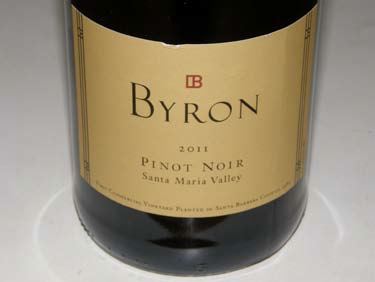
2011 Byron Santa Barbara County Pinot Noir
13.0% alc., pH 3.65, TA 0.50, $19. Aged 10
months in 20% new French oak barrels.
·
Moderate reddish-purple color in the glass. Very fragrant
with an array of aromas including dark berries, spice, Hoison, cigar box and oak. Flavorful plum
and boysenberry fruits with complimentary toasted and tobacco-imbued oak in the background. A
middleweight style with balanced tannins and easy drink ability. Very good concentration for the
vintage. A respectable representation of the Santa Barbara County region and an excellent valuepriced
wine for everyday drinking. Good.

2010 Cambria Estate Winery Julia’s Vineyard Santa Maria Valley Pinot Noir
14.6% alc., pH
3.59, TA 0.54, $25. Clones 4, 2A, 23, 667, 115, 12, 5 and 777. Aged 8 months in 26% new French
oak barrels. Week-long cold soak for optimum color and flavor extraction.
·
Moderately dark reddishpurple
color in the glass. Beautifully perfumed with aromas of boysenberry pie glaze, dark cherries,
black grapes, spice and just a hint of mocha. Very tasty core of moderately dark red, blue and black
berries with an earthy undertone, well-integrated oak and a polished mouth feel. A quintessential
Santa Maria Valley wine that has respectable power, good finishing length and enough spirit to be thoroughly
satisfying. Very good.
2010 Cambria Bench Break Santa Maria Valley Pinot Noir
14.3% alc, $34. Sourced from the Bench Break
Vineyard that has very shallow soils. Although this vineyard usually produces an opulent wine, the wine has
more restraint in this vintage. Tasted at the World of Pinot Noir.
·
The nose is open and expressive with scents of
fresh red and black cherries and berries. The fresh fruit flavors are enhanced by an earthy, grilled mushroom
riff. Very smooth on the palate with restrained tannins and a bright black cherry finish. I like this a lot.
Very good.

2009 Dierberg Estate Grown Santa Maria Valley Pinot Noir
14.5% alc., pH 3.81, $42 (often
priced by retailers at $35). Dierberg Vineyard is situated on top a sandy loam mesa above the
southern bank of the Santa Maria River, in the far western portion of the Santa Maria AVA. Its
proximity to the ocean makes it one of the coolest vineyards in the AVA. Planted in 1997, the
vineyard is planted to 11 different clones include 60% Dijon and 40% heritage types. 1 month on
skins, aged 18 months in 33% new French oak barrels. Unfined and unfiltered.
·
Moderately dark
reddish-purple hue in the glass. Penetrating aromas of black plum, blackberry, black currant and
forest floor on the nose with a hint of oak. Impressive flavor attack on entry carrying through to a powerful fruitdriven
finish. There are charming flavors of blackberries, Hoison sauce, anise and spice with well-managed
oak in the background. Very soft on the palate with good supporting acidity. Much better later in the day from
a previously opened and re-corked bottle. Very good.

2010 Presqu’ile Winery Presqu’ile Estate Vineyard Santa Maria Valley Pinot Noir
13.46% alc., TA 0.561,
$55. First 100% estate grown wine. 100% whole cluster. 60% clone 777, 40% clone 667. Aged 17 months in
35% new French oak barrels. Tasted briefly at World of Pinot Noir.
·
Welcome whole cluster spice and structure
with a delicious cherry core, fine tannins and a very focused finish. Very good.
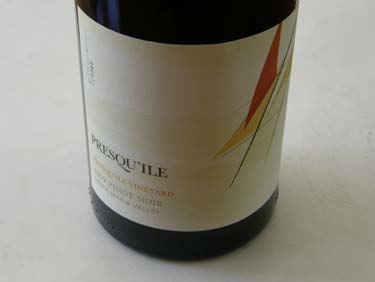
The Chardonnay Symposium: Tickets are now on sale for The Chardonnay Symposium in Santa Maria
Valley July 19-21. The weekend full of events will include a Dinner Tribute to Jim Clendenen at the Historic
Bien Nacido Adobe on Friday, July 19, and The Chardonnay Symposium and Grand Chardonnay Tasting at
Byron Vineyard & Winery on Saturday, July 20. For tickets and information visit
www.thechardonnaysymposium.com.










